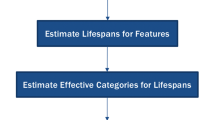Abstract
Mining the association rules in the alarm data generated by network is an important method for operations to monitor and manage the network equipment. Analyzing the correlation of alarms through association rule mining algorithms can effectively simplify alarms and help locate network faults. Since the network alarm data has an obvious chronological relationship, it needs to be processed by the association rule mining algorithm based on time series. Through investigation, it is found that current association rule algorithms based on time series lack the determination of the realistic cause-and-effect relationship between successive alarms. Therefore, in order to improve the effectiveness of the association algorithm, this paper adopts an association mining algorithm based on the existing time series, which supports filtering the useless sequential associated items that have no causal relationship in the results. The experimental and analytical results show that the proposed method is effective.
Access this chapter
Tax calculation will be finalised at checkout
Purchases are for personal use only
Similar content being viewed by others
References
Zhang, G., Liu, C., Men, T.: Research on data mining technology based on association rules algorithm. In: IEEE 8th Joint International Information Technology and Artificial Intelligence Conference (ITAIC), pp. 526–530. IEEE (2019)
Du, J., Luo, H.: Network security situation analysis of weighted neural network with association rules mining. In: Proceedings of the 2016 5th International Conference on Advanced Materials and Computer Science (2016)
Yuan, X.: An improved Apriori algorithm for mining association rules. In: AIP Conference Proceedings. Vol. 1820. No. 1. AIP Publishing LLC (2017)
Chang, H-Y., et al.: A novel incremental data mining algorithm based on fp-growth for big data. In: International Conference on Networking and Network Applications (NaNA), pp. 375–378. IEEE (2016)
Chen, C., Wang, D.: Research on association rules mining base on positive and negative items of FP-tree. In: 2016 6th International Conference on Machinery, Materials, Environment, Biotechnology and Computer. Atlantis Press, pp. 1395–1399 (2016)
Wang, J., et al.: Association rules mining based analysis of consequential alarm sequences in chemical processes. J. Loss Prev. Process Ind. 41, 178–185 (2016)
Tarus, J.K., Niu, Z., Kalui, D.: A hybrid recommender system for e-learning based on context awareness and sequential pattern mining. Soft. Comput. 22(8), 2449–2461 (2017). https://doi.org/10.1007/s00500-017-2720-6
Ge, J., Xia, Y., Wang, J., Nadungodage, C.H., Prabhakar, S.: Sequential pattern mining in databases with temporal uncertainty. Knowl. Inf. Syst. 51(3), 821–850 (2016). https://doi.org/10.1007/s10115-016-0977-1
Zhai, L., et al.: Temporal association rule mining based on T-Apriori algorithm and its typical application. In: Proceedings of International Symposium on Spatio-Temporal Modeling, Spatial Reasoning, Analysis, Data Mining and Data Fusion (2005)
Han, J., et al.: Prefixspan: mining sequential patterns efficiently by prefix-projected pattern growth. In: Proceedings of the 17th International Conference on Data Engineering. IEEE Washington, DC, USA (2001)
Acknowledgement
This work is supported by the National Natural Science Foundation of China under Grant No. 61771072 and the Industrial technology basic public service platform with project No. 2019–00899-3–1.
Author information
Authors and Affiliations
Corresponding authors
Editor information
Editors and Affiliations
Rights and permissions
Copyright information
© 2021 Springer Nature Switzerland AG
About this paper
Cite this paper
Liu, Y., Man, Y., Cui, J. (2021). Research on Alarm Causality Filtering Based on Association Mining. In: Zu, Q., Tang, Y., Mladenović, V. (eds) Human Centered Computing. HCC 2020. Lecture Notes in Computer Science(), vol 12634. Springer, Cham. https://doi.org/10.1007/978-3-030-70626-5_47
Download citation
DOI: https://doi.org/10.1007/978-3-030-70626-5_47
Published:
Publisher Name: Springer, Cham
Print ISBN: 978-3-030-70625-8
Online ISBN: 978-3-030-70626-5
eBook Packages: Computer ScienceComputer Science (R0)




